Sir John Monash, Personal Files Book 6, 10 June - 12 July 1915, Part 7
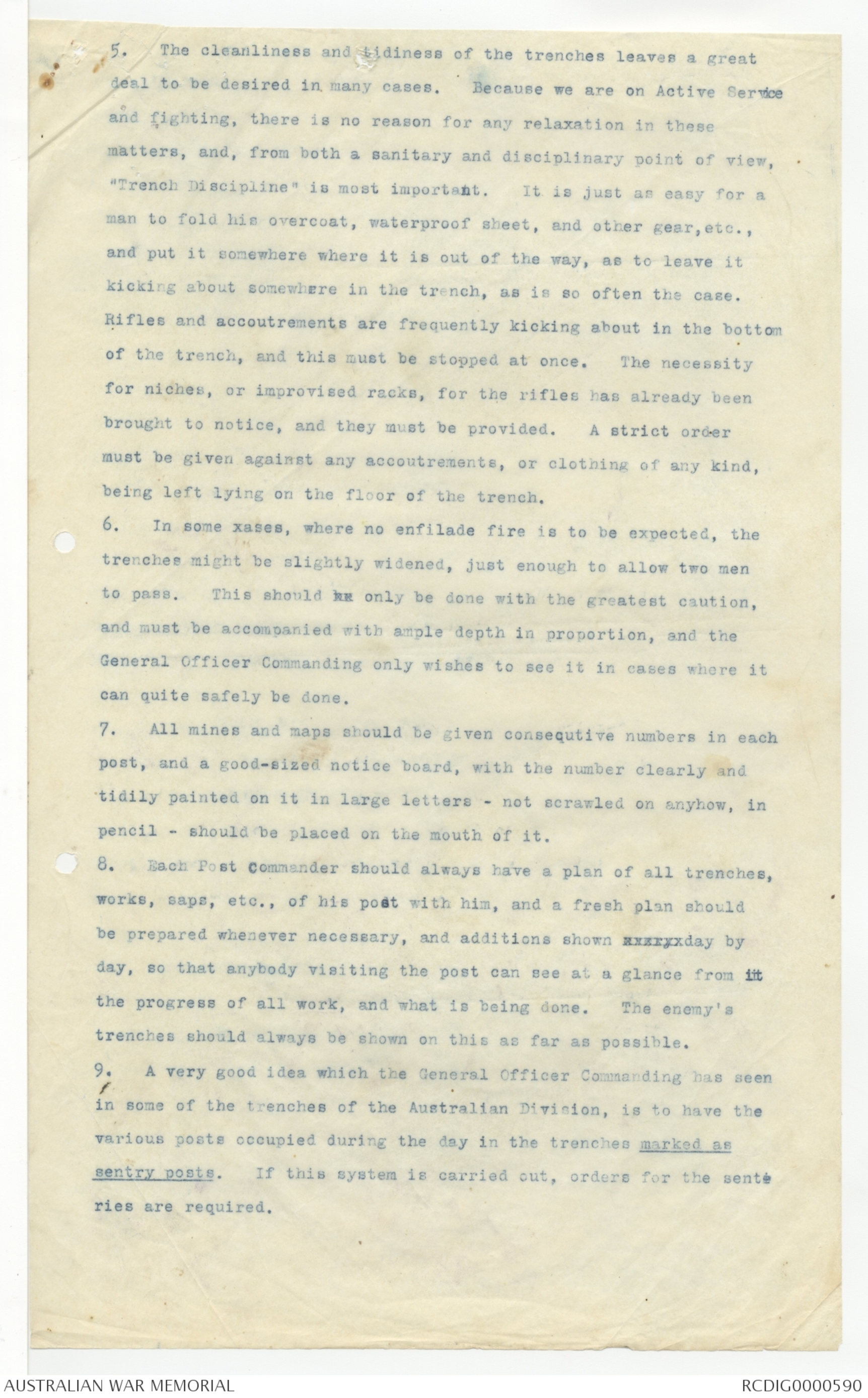
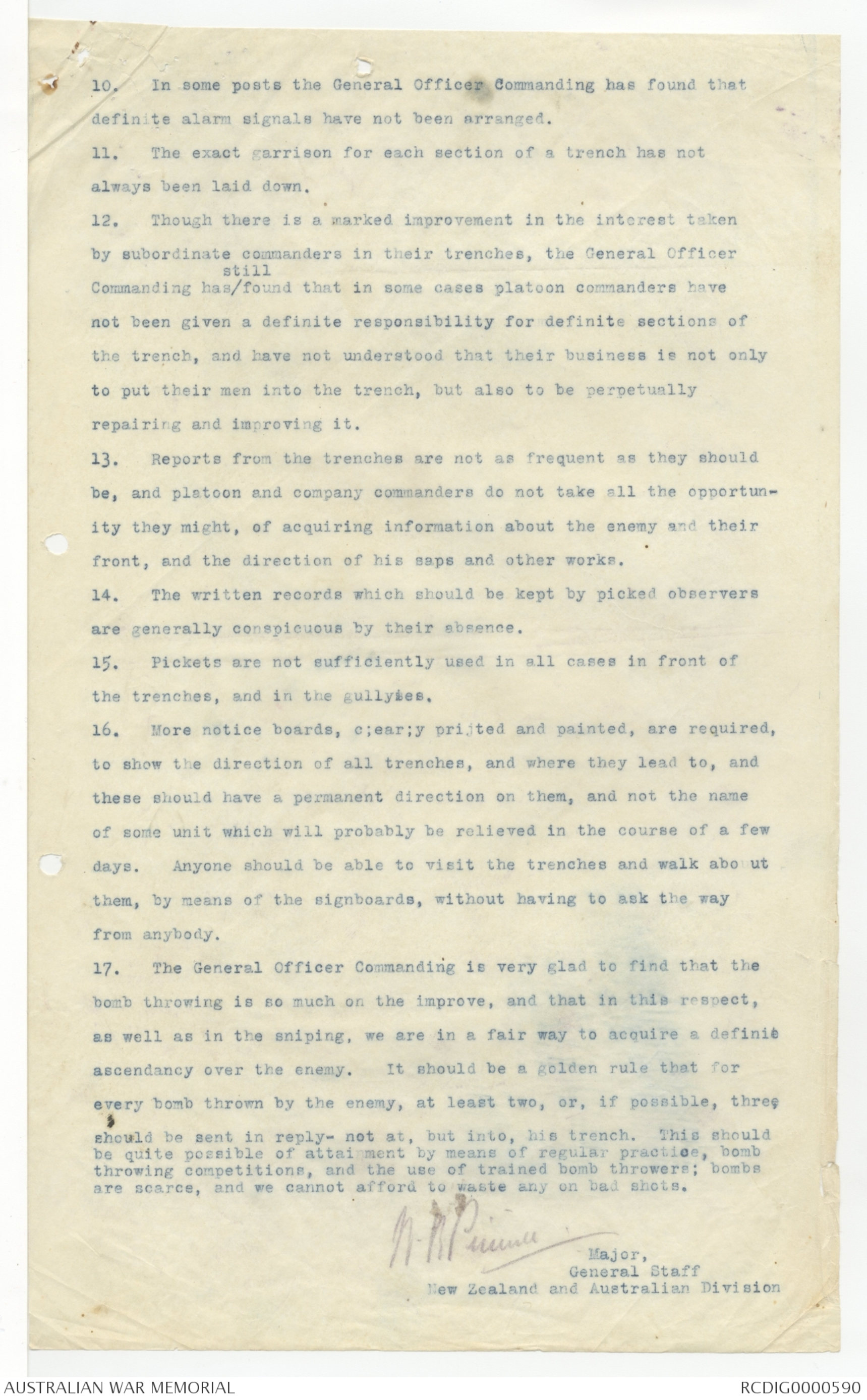
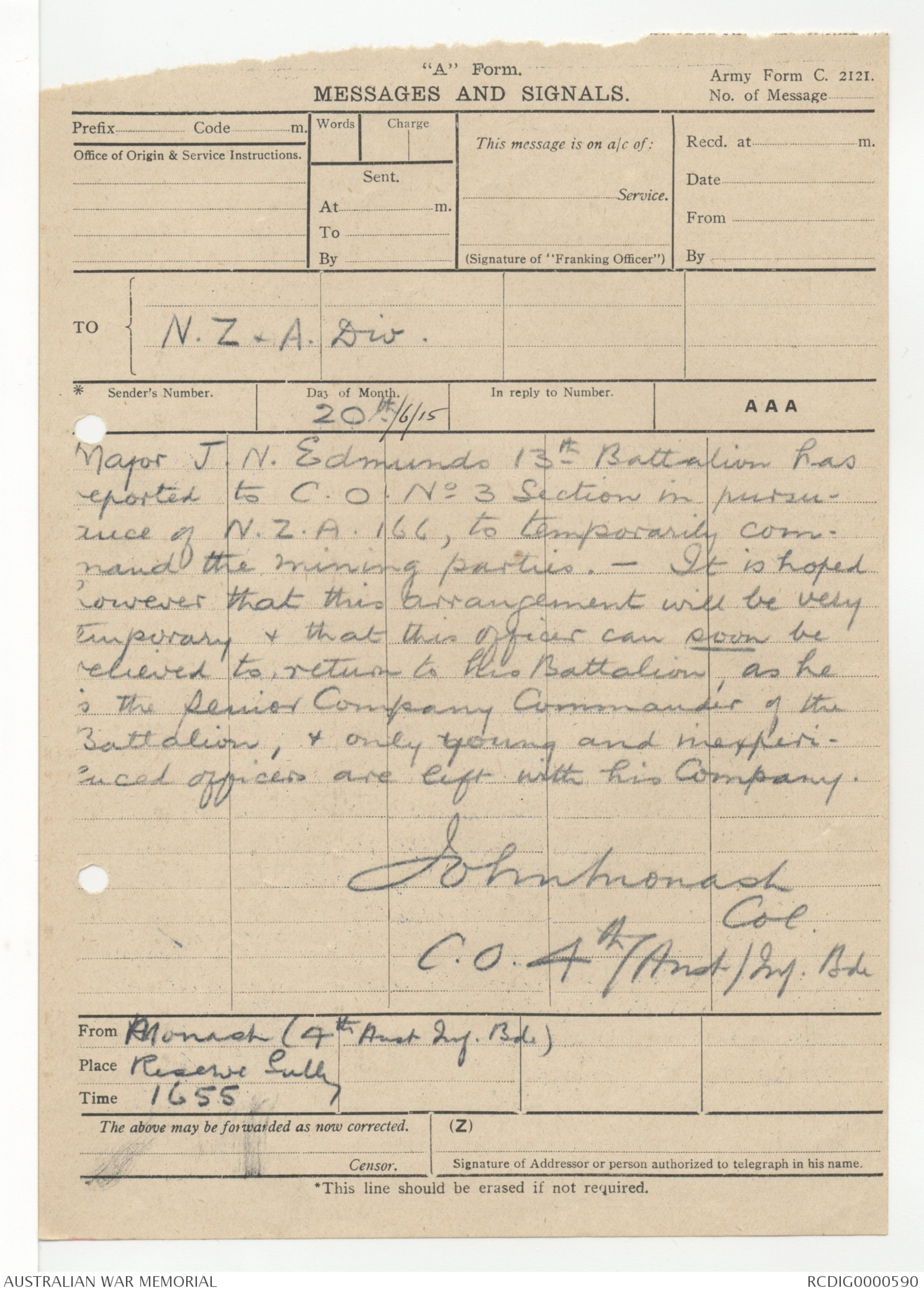
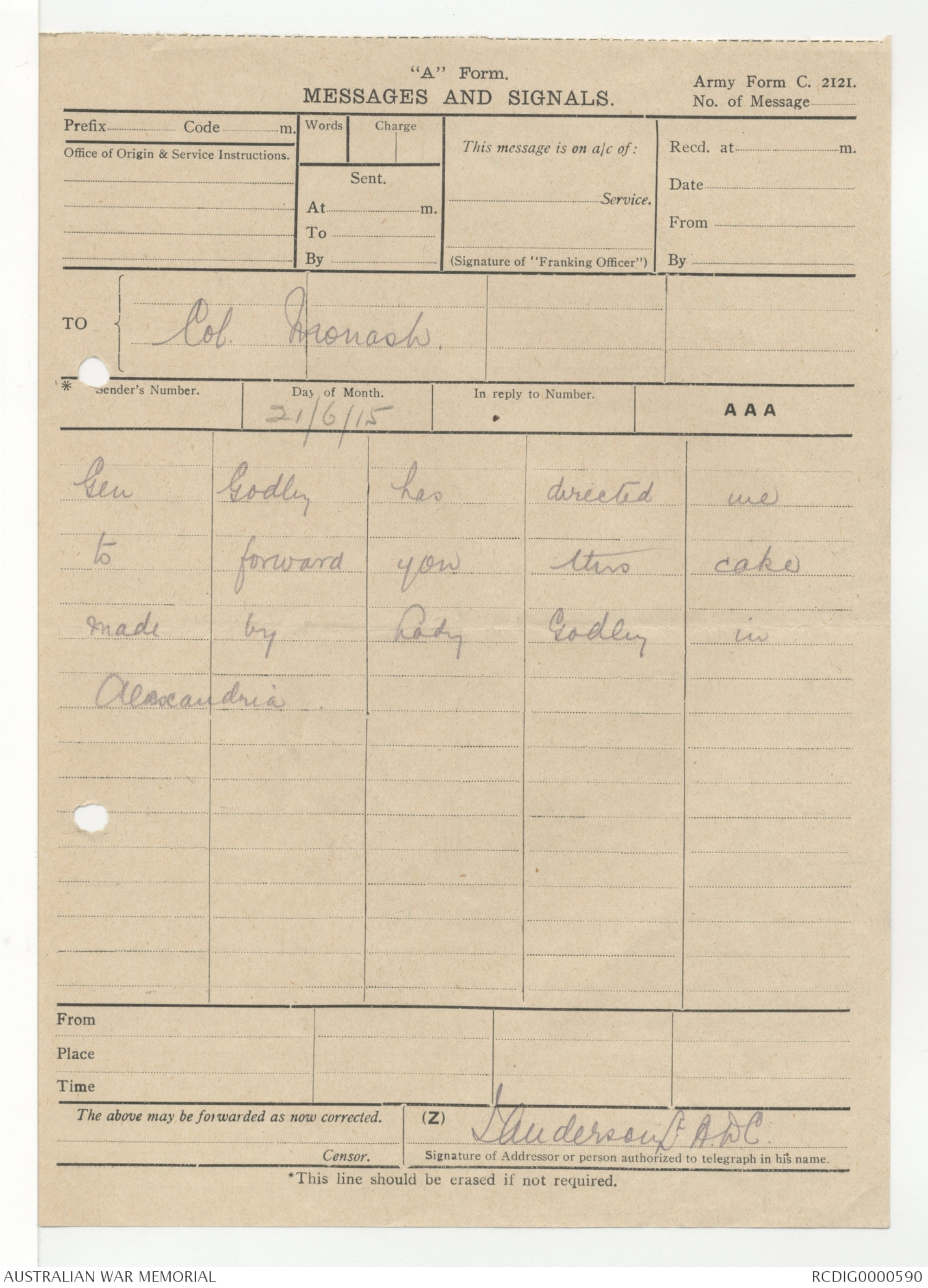
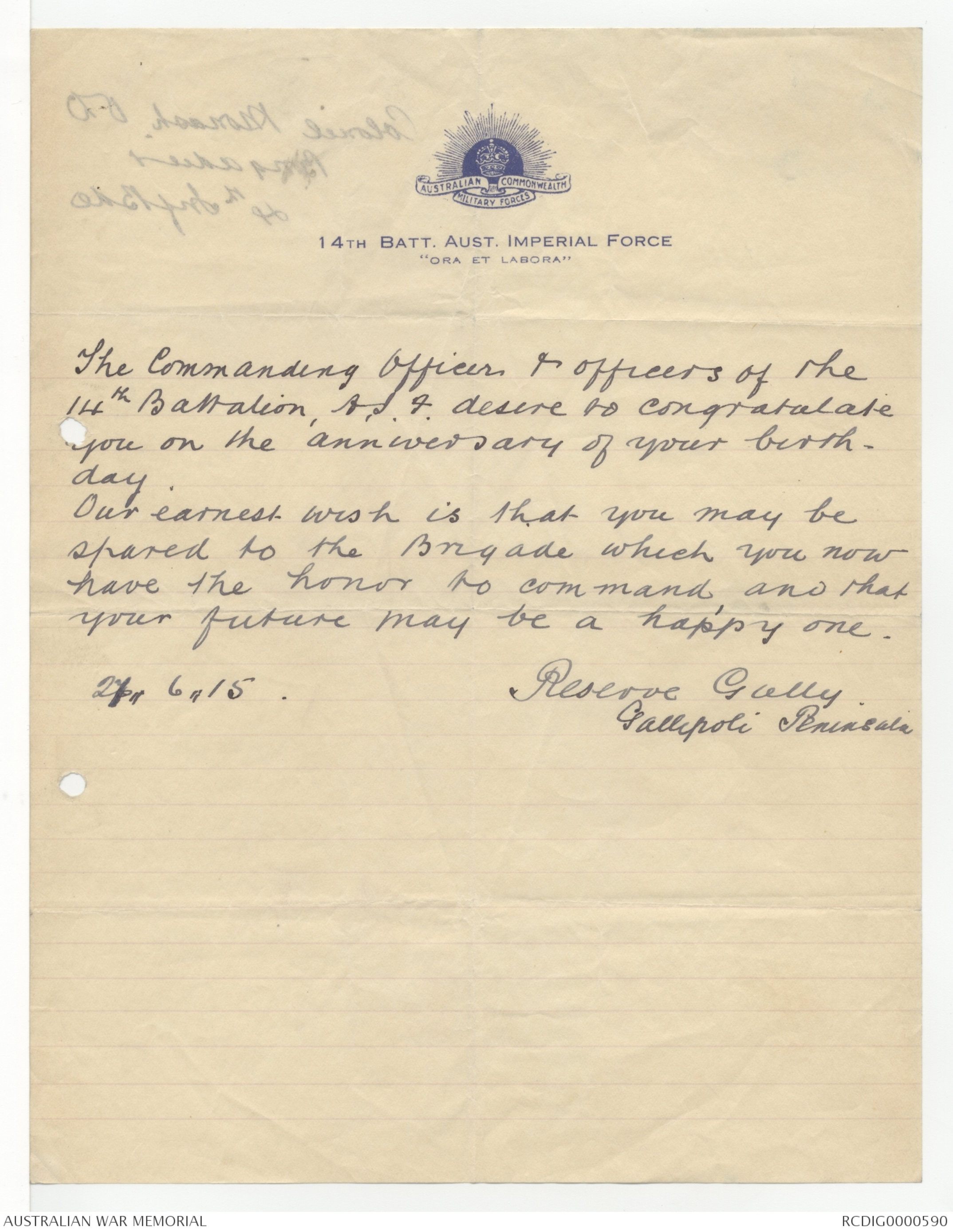
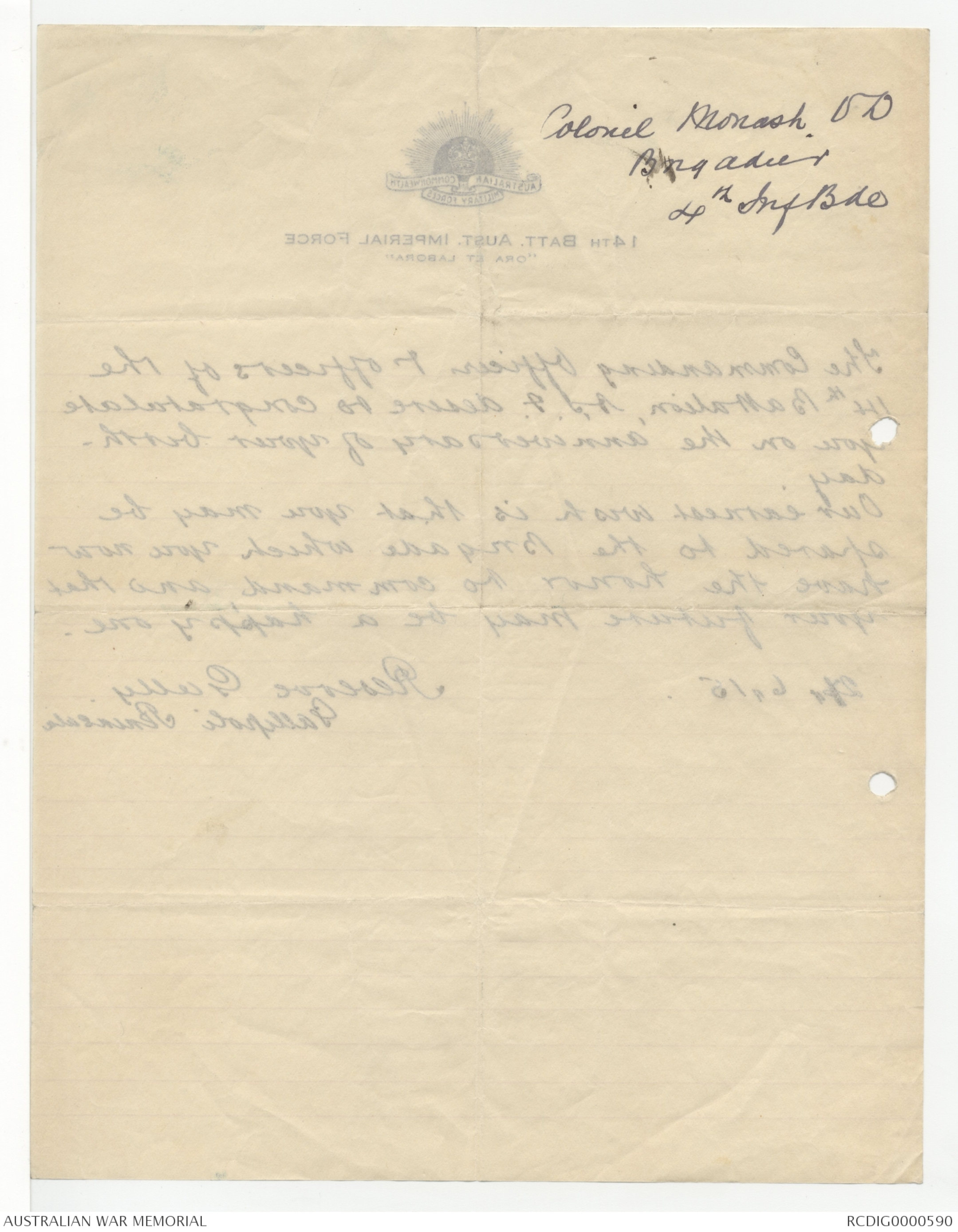
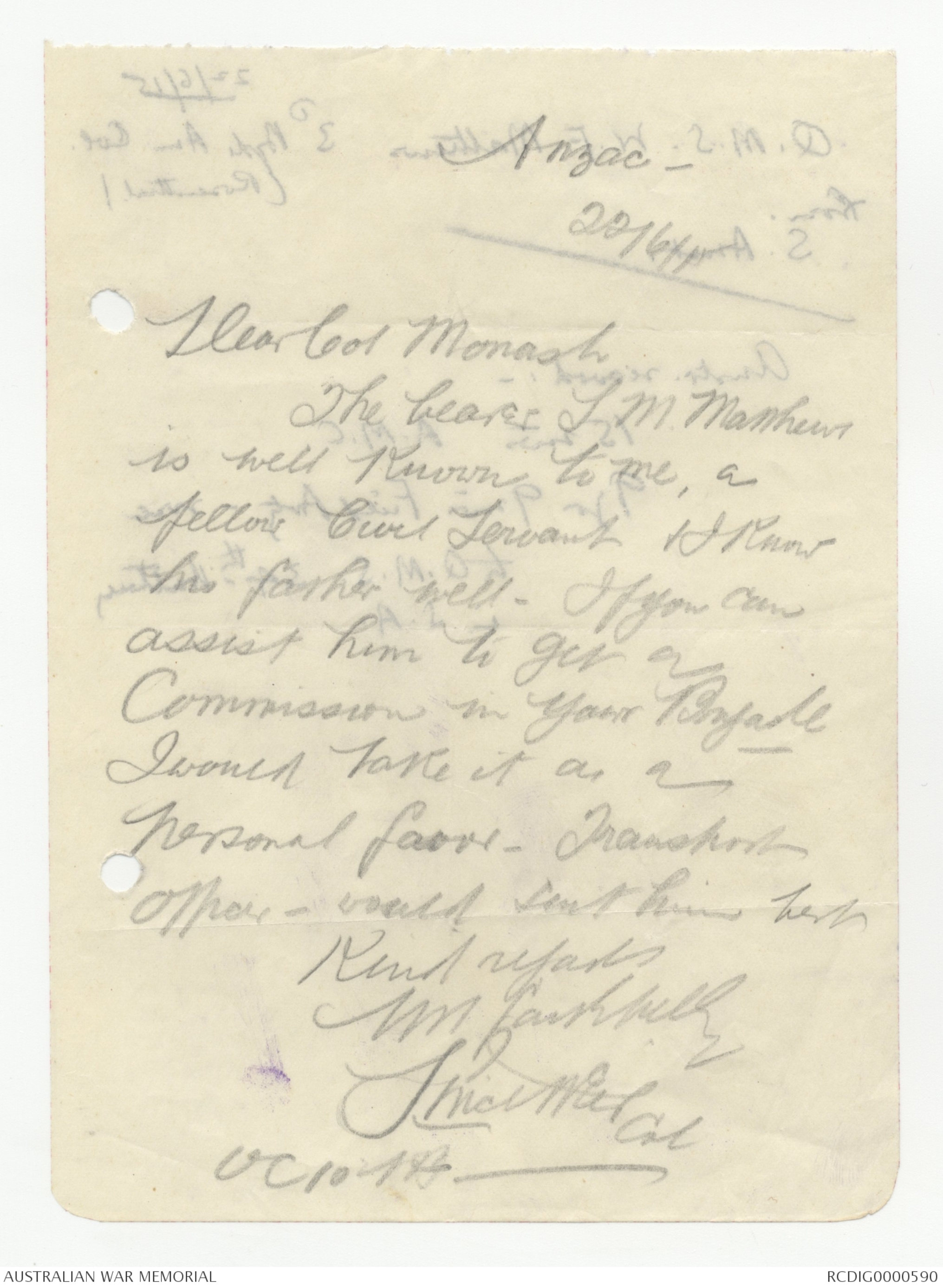
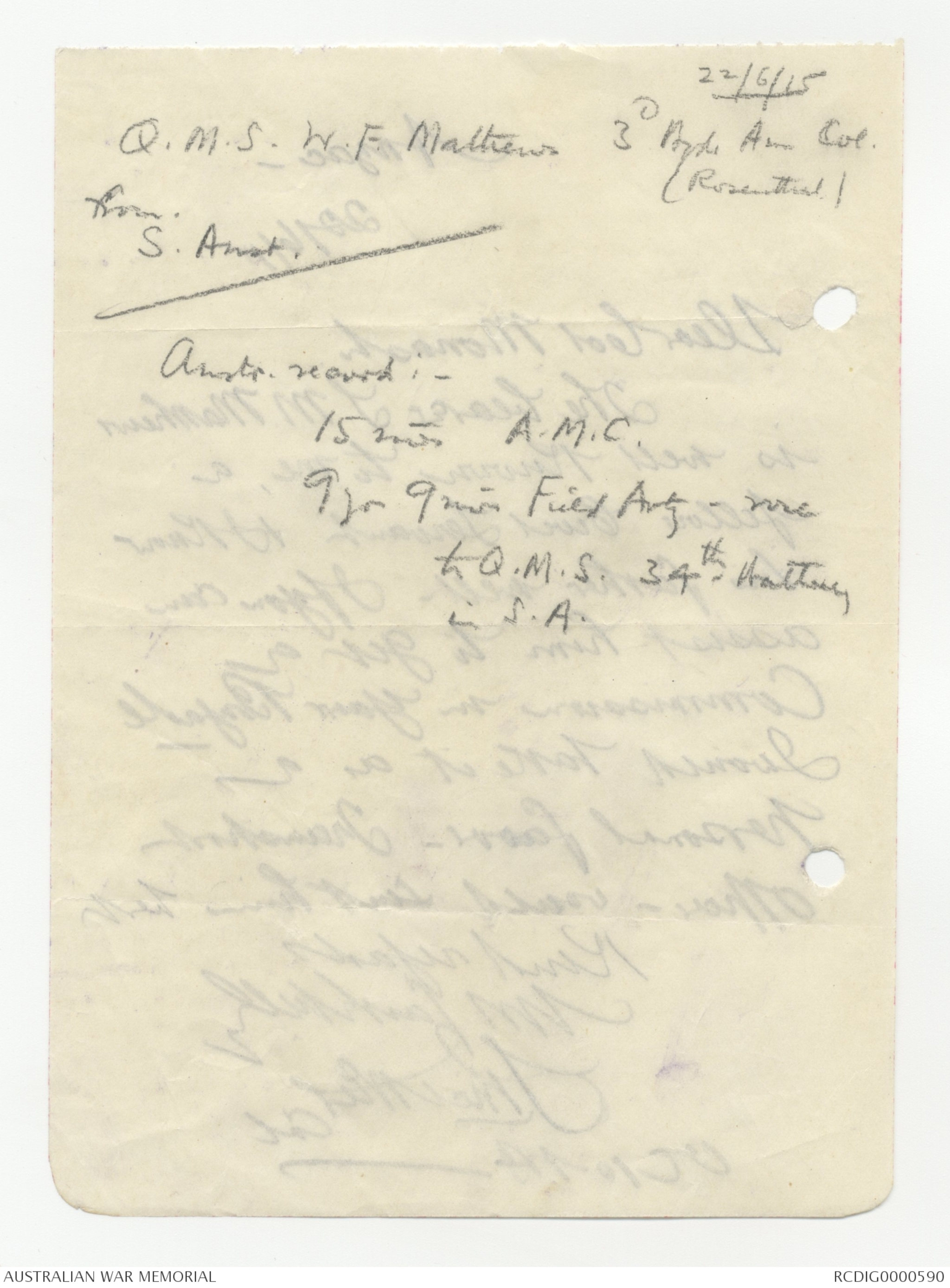
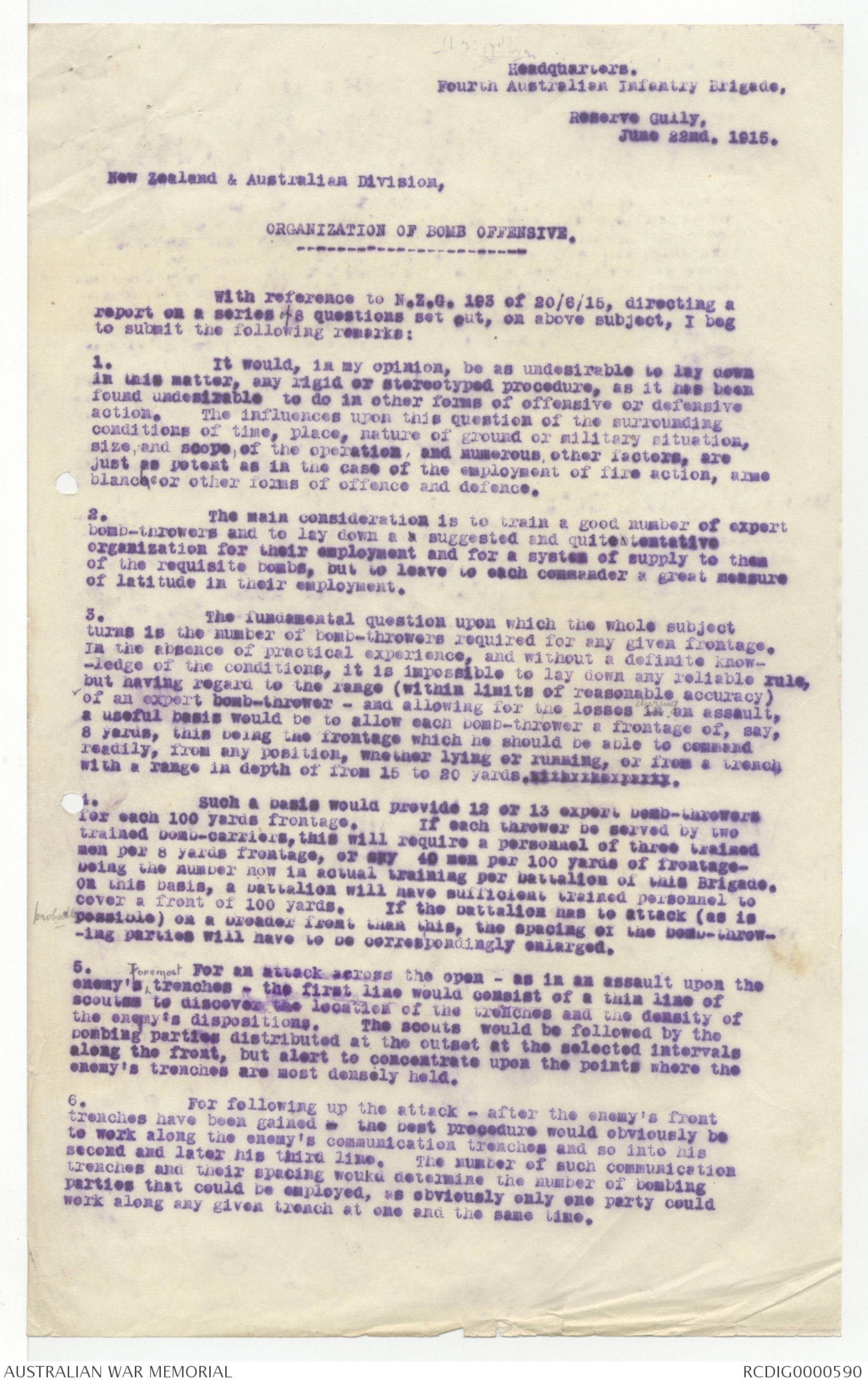
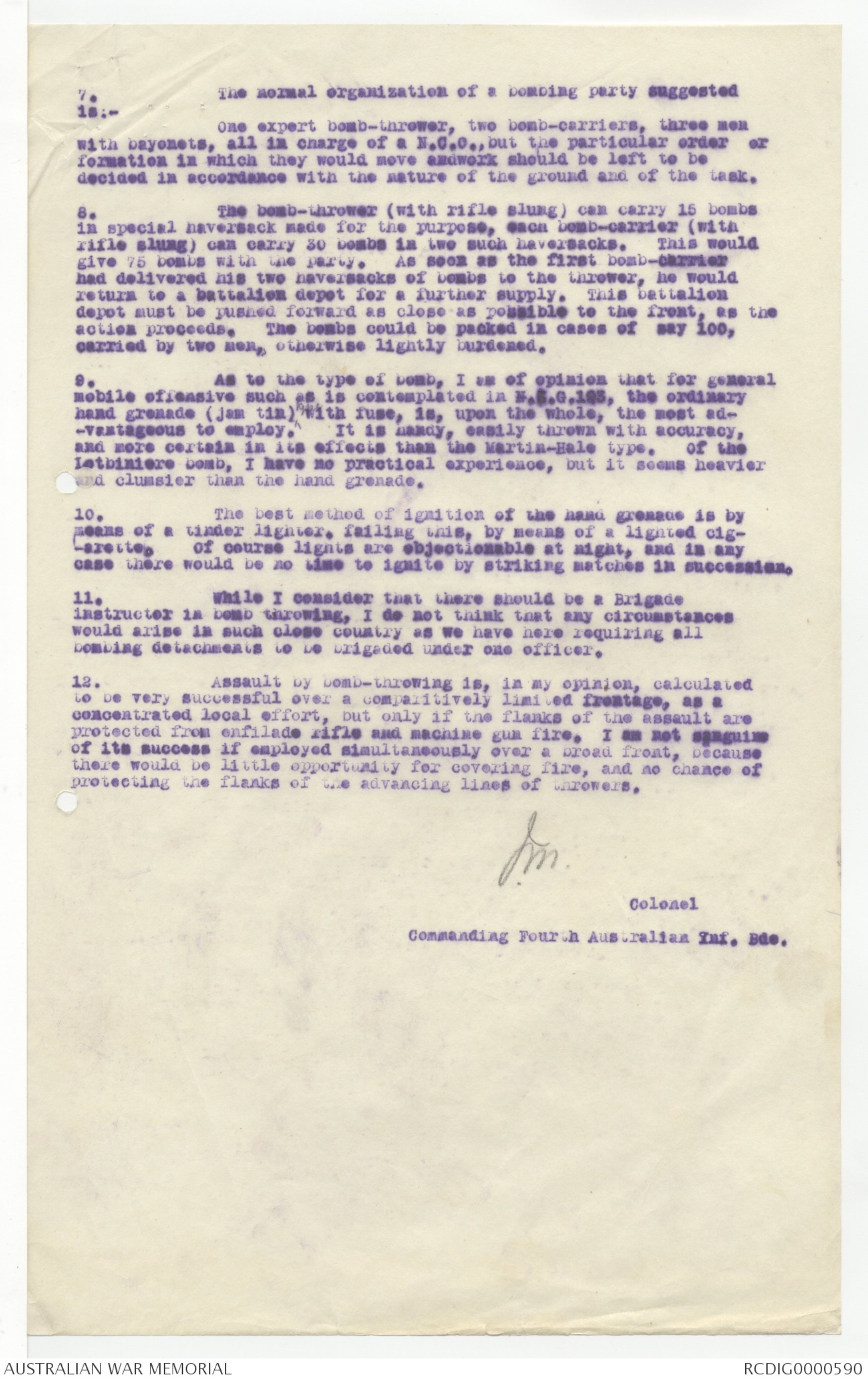
5. The cleanliness and tidiness of the trenches leaves a great
deal to be desired in many cases. Because we are on Active Service
and fighting, there is no reason for any relaxation in these
matters, and, from both a sanitary and disciplinary point of view,
"Trench Discipline" is most important. It is just as easy for a
man to fold his overcoat, waterproof sheet, and other gear, etc.,
and put it somewhere where it is out of the way, as to leave it
kicking about somewhere in the trench, as is so often the case.
Rifles and accoutrements are frequently kicking about in the bottom
of the trench, and this must be stopped at once. The necessity
for niches, or improved racks, for the rifles has already been
brought to notice, and they must be provided. A strict order
must be given against any accoutrements, or clothing of any kind,
being left lying on the floor of the trench.
6. In some xases, where no enfilade fire is to be expected, the
trenches might be slightly widened, just enough to allow two men
to pass. This should be only be done with the greatest caution,
and must be accompanied with ample depth in proportion, and the
General Officer Commanding only wishes to see it in cases where it
can quite safely be done.
7. All mines and maps should be given consecutive numbers in each
post, and a good-sized notice board, with the number clearly and
tidily painted on it in large letters - not scrawled on anyhow, in
pencil - should be placed on the mouth of it.
8. Each Post Commander should always have a plan of all trenches,
works, saps, etc., of his post with him, and a fresh plan should
be prepared whenever necessary, and additions shown everyday by
day, so that anybody visiting the post can see at a glance from it
the progress of all work, and what is being done. The enemy's
trenches should always be shown on this as far as possible.
9. A very good idea which the General Officer Commanding has seen
in some of the trenches of the Australian Division, is to have the
various posts occupied during the day in the trenches marked as
sentry posts. If this system is carried out, orders for the sentries
are required,
10. In some posts the General Officer Commanding has found that
definite alarm signals have not been arranged.
11. The exact garrison for each section of a trench has not
always been laid down.
12. Though there is a marked improvement in the interest taken
by subordinate commanders in their trenches, the General Officer
Commanding has still found that in some cases platoon commanders have
not been given a definite responsibility for definite sections of
the trench, and have not understood that their business is not only
to put their men into the trench, but also to be perpetually
repairing and improving it.
13. Reports from the trenches are not as frequent as they should
be, and platoon and company commanders do not take all the opportunities
they might, of acquiring information about the enemy and their
front, and the direction of his saps and other works.
14. The written reports which should be kept by picked observers
are generally conspicuous by their absence.
15. Pickets are not sufficiently used in all cases in front of
the trenches, and in the gullyies.
16. More notice boards, clearly printed and painted, are required,
to show the direction of all trenches, and where they lead to, and
these should have a permanent direction on them, and not the name
of some unit which will probably be relieved in the course of a few
days. Anyone should be able to visit the trenches and walk about
them, by means of the signboards, without having to ask the way
from anybody.
17. The General Officer Commanding is very glad to find that the
bomb throwing is so much on the improve, and that in this respect
as well as in the sniping, we are in a fair way to acquire a definite
ascendancy over the enemy. It should be a golden rule that for
every bomb thrown by the enemy, at least two, or if possible, three
should be sent in reply - not at, but into his trench. This should
be quite possible of attainment by means of regular practice, bomb
throwing competitions, and the use of trained bomb throwers; bombs
are scarce, and we cannot to waste any on bad shots.
N.R. [[Prince?]]
Major,
General Staff
New Zealand and Australian Division
"A" Form.
Army Form C. 2121.
No. of Message
MESSAGES AND SIGNALS.
Prefix Code m. Words Charge
Office of Origin & Service Instructions.
This message is on a/c of :
..... Service.
(Signature of "Franking Officer")
Recd. at .... m.
Date ....
From ....
By ...
Sent.
At .... m.
To ....
By ....
TO N.Z & A. Div
* Sender's Number. Day of Month. In reply to Number. A A A
20th/6/15
Major J.N. Edmunds 13th Battalion has
reported to C.O. No 3 Section in pursuance
of N.Z.A. 166, to temporarily command
the mining parties. - It is hoped
however that this arrangement will be very
temporary & that this officer can soon be
relieved to return to his Battalion, as he
is the Senior Company Commander of the
Battalion, & only young and inexperienced
officers are left with his Company.
John Monash
Col.
C.O. 4th (Aust) Inf. Bde
From Monash (4th Aust Inf. Bde)
Place Reserve Gully
Time 1655
The above may be forwarded as now corrected.
.... Censor.
(Z)
Signature of Addressor or person authorized to telegraph in his name.
*This line should be erased if not required.
"A" Form.
Army Form C. 2121.
No. of Message
MESSAGES AND SIGNALS.
Prefix Code m. Words Charge
Office of Origin & Service Instructions.
This message is on a/c of :
..... Service.
(Signature of "Franking Officer")
Recd. at .... m.
Date ....
From ....
By ...
Sent.
At .... m.
To ....
By ....
TO Col. Monash
* Sender's Number. Day of Month. In reply to Number. A A A
21/6/15
Gen Godley has directed me
to forward you this cake
made by Lady Godley in
Alexandria.
From
Place
Time
The above may be forwarded as now corrected.
.... Censor.
(Z)
L Anderson Lt A.W.C.
Signature of Addressor or person authorized to telegraph in his name.
*This line should be erased if not required.
AUSTRALIAN COMMONWEALTH
MILITARY FORCES
14TH BATT. AUST. IMPERIAL FORCE
"ORA ET LABORA"
The Commanding Officer & Officers of the
14th Battalion, A.I.F. desire to congratulate
you on the anniversary of your birthday.
Our earnest wish is that you may be
spared to the Brigade which you now
have the honor to command, and that
your future may be a happy one.
21/6/15 .
Reserve Gully
Gallipoli Peninsula
Colonel Monash V D
Brigadier
4th Inf Bde
Anzac
22/6/15
Dear Col Monash
The bearer S M. Matthews
is well known to me, a
fellow Civil Servant & I know
his father well. If you can
assist him to get a
Commission in your Brigade
I would take it as a
personal favor _ Transport
Officer _ would suit him best
Kind regards
Yrs faithfully
S McWeir
Col
OC 10th _____
22/6/15
Q.M.S. W.F. Mathews 3d Bgde Am Col.
(Rosenthal)
from.
S. Aust.
Austr. record:-
15 mths A.M.C.
9 yrs 9 mths Field Arty - rose
to Q.M.S. 34th Battery
in S.A.
Headquarters.
Fourth Australian Infantry Brigade,
Reserve Gully,
June 22nd, 1915.
New Zealand & Australian Division,
ORGANIZATION OF BOMB OFFENSIVE.
With reference to N.Z.G. 193 of 20/6/15, directing a
report on a series of 8 questions set out, on above subject, I beg
to submit the following remarks:
1. It would, in my opinion, be as undesirable to lay down
in this matter, any rigid or stereotyped procedure, as it has been
found undesirable to do in other forms of offensive or defensive
action. The influences upon this question of the surrounding
conditions of time, place, nature of ground or military situation,
size, and scope of the operation, and numerous other factors, are
just as potent as in the case of the employment of fire action, arme
blanche or other forms of offence and defence.
2. The main consideration is to train a good number of expert
bomb-throwers and to lay down a a suggested and quite tentative
organization for their employment and for a system of supply to them
of the requisite bombs, but to leave to each commander a great measure
of latitude in their employment.
3. The fundamental question upon which the whole subject
turns is the number of bomb-throwers required for any given frontage.
In the absence of practical experience, and without a definite knowledge
of the conditions, it is impossible to lay down any reliable rule,
but having regard to the range (within limits of reasonable accuracy)
of an expert bomb-thrower - and allowing for the losses in ^during an assault,
a useful basis would be to allow each bomb-thrower a frontage of, say,
8 yards, from any position, whether lying or running, or from a trench
with a range in depth of from 15 to 20 yards. xxxxxxxxx.
4. Such a basis would provide 12 or 13 expert bomb-throwers
for each 100 yards frontage. If such a thrower be served by two
trained bomb-carriers, this will require a personnel of three trained
men per 8 yards frontage, or say 40 men per 100 yards of frontage-
using the number now in actual training per battalion of this Brigade.
On this basis, a battalion will have sufficient trained personnel to
cover a front of 100 yards. If the battalion has to attack (as is
probable possible) on a broader front than this, the spacing of the bomb-throwing
parties will have to be correspondingly enlarged.
5. For an attack across the open - as in an assault upon the
enemy's ^foremost trenches - the first line would consist of a thin line of
scouts to discover the location of the trenches and the density of
the enemy's dispositions. The scouts would be followed by the
bombing parties distributed at the outset at the selected intervals
along the front, but alert to concentrate upon the points where the
enemy's trenches are most densely held.
6. For following up the attack - after the enemy's front
trenches have been gained - the best procedure would obviously be
to work along the enemy's communication trenches and so into his
second and later his third line. The number of such communication
trenches and their spacing would determine the number of bombing
parties that could be employed, as obviously only one party could
work along any given trench at one and the same time.
7. The normal organization of a bombing party suggested
is;-
One expert bomb-thrower, two bomb-carriers, three men
with bayonets, all in charge of a N.C.O., but the particular order or
formation in which they would move andwork should be left to be
decided in accordance with the nature of the ground and of the task.
8. The bomb-thrower (with rifle slung) can carry 15 bombs
in special haversack made for the purpose, each bomb-carrier (with
rifle slung) can carry 30 bombs in two such haversacks. This would
give 75 bombs with the party. As soon as the first bomb-carrier
has delivered his two haversacks of bombs to the thrower, he would
return to a battalion depot for a further supply. This battalion
depot must be pushed forward as close as possible to the front, as the
action proceeds. The bombs could be packed in cases of say 100,
carried by two men, otherwise lightly burdened.
9. As to the type of bomb, I am of the opinion that for general
mobile offensive such as is contemplated in N.Z.G. 193, the ordinary
hand grenade (jam tin) ^type with fuse, is, upon the whole, the most advantageous
to employ. It is handy, easily thrown with accuracy,
and more certain in its effects than the Martin-Hale type. Of the
Letbiniere bomb, I have no practical experience, but it seems heavier
and clumsier than the hand grenade.
10. The best method of ignition of the hand grenade is by
means of a tinder lighter, failing this, by means of a lighted cigarette.
Of course lights are objectionable at night, and in any
case there would be no time to ignite by striking matches in succession.
11. While I consider that there should be a Brigade
instructor in bomb-throwing, I do not think that any circumstance
would arise in such close country as we have here requiring all
bombing detachments to be brigaded under one officer.
12. Assault by bomb-throwing is, in my opinion, calculated
to be very successful over a comparatively limited frontage, as a
concentrated local effort, but only if the flanks of the assault are
protected from enfilade rifle and machine gun fire. I am not sanguine
of its success if employed simultaneously over a broad front, because
there would be little opportunity for covering fire, and no chance of
protecting the flanks of the advancing line of throwers.
J.M.
Colonel
Commanding Fourth Australian Inf. Bde.
 Jacqueline Kennedy
Jacqueline KennedyThis transcription item is now locked to you for editing. To release the lock either Save your changes or Cancel.
This lock will be automatically released after 60 minutes of inactivity.